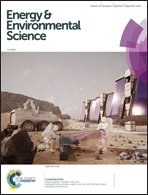Realizing a thermoelectric conversion efficiency of 12% in bismuth telluride/skutterudite segmented modules through full-parameter optimization and energy-loss minimized integration†
Abstract
In recent decades, by continuously enhancing the figure of merit ZT of various thermoelectric (TE) materials, solid state TE technology has matured and is on the verge of making an impact in real industrial settings as a promising approach to harvest waste industrial heat and convert it to useful electricity. Nevertheless, actual TE module development has remained stagnant with rather poor efficiencies. This has raised an urgent need to design rational module structures that rely on complex parameter optimization and utilization of efficient integration technologies that minimize energy losses during bonding of various interfaces. Here, we demonstrate a three-dimensional numerical analysis model of a segmented TE power-generating device, which takes into account the temperature-dependent materials' properties and various parasitic losses. The model generates an optimized design with predictive performance to realize maximum conversion efficiency. Combined with the developed bonding schemes and assembly techniques, the segmented modules consisting of Bi2Te3-based alloys and CoSb3-based filled skutterudites were successfully fabricated with a record-high efficiency of up to 12% when operating under a temperature difference of 541 °C. The rational structure design based on the numerical analysis model and the extremely low thermal and electrical losses enable the heat-to-electricity conversion efficiency to reach up to 96.9% of the theoretical efficiency based on the TE materials themselves. These findings highlight the importance of the optimization strategy for TE power generation devices based on the TE materials' intrinsic properties and demonstrate that realistic high temperature TE modules with predictive high efficiency and high power density can be fabricated, which provides a useful guide to achieve a high conversion efficiency in large-scale TE applications.



 Please wait while we load your content...
Please wait while we load your content...